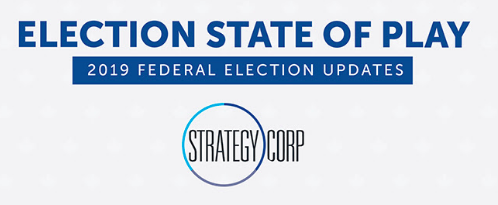

| Election 43: Week One The first week of the campaign did not move the dial on public opinion for any of the campaigns, with polling remaining static and within the margin of error. The Conservatives and Liberals remain essentially tied in the mid-30s. The focus has been on laying the groundwork for the release of their campaign platforms in a few weeks. Unfortunately for all parties, none of their positive campaign elements were at the top of the agenda. All the parties in the first week were on the defensive over previous statements made by their candidates on social media or other fora and these issues grabbed most of the headlines. So far, five candidates have resigned. An additional one was lost right before the writ dropped. War room operators have sought to move past these “candidate eruptions” by focussing on the ballot box question they would like voters to ask themselves. Ballot box questions can change throughout a campaign and sometimes, to the chagrin of those working hard in campaign war rooms, they end up being framed by events outside of a party’s control. It’s still early in the campaign and new issues can arise, but the ballot question for the Conservatives is “Which party will leave more money in your pocket?” The question for the Liberals is, “What kind of Canada do you want to live in?” Since the 1980s, no election has resulted in the two most popular parties finishing within 5% of each other in the popular vote. While this election remains fluid regarding what will drive the final result, we know what the political campaigns are hoping to fight it on. Go In Depth: Missed last week’s update? Get the details on the campaign kick-off. |
| LiberalsThe Liberals met their three major strategic objectives for the first week: 1) establish the election as a two-party choice between the Liberals and Conservatives in the minds of media and opinion leaders; 2) reinforce their progressive bona fides to Liberal, NDP and Green voters via paid and social channels; 3) lay down track that the Conservatives are a return to Harper, scary on social issues and intend service cuts. The polling numbers did much of the work on the first objective for them, and on the second, the Liberals deliberately borrowed the BC NDP’s plan for taxing non-resident investment properties to signal to BC progressives that they have a place with Trudeau, with similar announcements on child-care, and tax-free maternity and parental benefits. A series of attacks on Conservative candidates for socially conservative positions helped establish the Liberal’s third objective among the media – a necessary first step to reinforcing it in public opinion. Whether the Liberals overplay this strategy, as they did in the 2005-06 campaign, remains in question. Tactically, the Liberals’ visuals are not as strong as they were in 2015, with Trudeau typically behind a podium and invariably indoors. This may be the result of security concerns, but it has an impact on 2015 vs. 2019 Trudeau. An exception is the Thursday night rally in Edmonton that gave a glimpse of the gifted image-making that helped Team Trudeau move from third to first last time. Expect the campaign to adapt and improve the visuals over the next week. |
| ConservativesThe Tories want to fight this election on the theme of affordability with their slogan “It’s time for you to get ahead.” This approach has been reinforced with targeted announcements making EI maternity benefits tax free, a renewal of the Harper-era niche tax credits for public transit and children’s arts and sports, and a “Universal Tax Cut” to reduce the lower income tax bracket. The first week of the campaign ended in a wash for the Conservatives. Their positive announcements had to compete with the fallout from past social media posts from certain candidates, resulting in the turfing of one and playing defence on a couple others. Scrutiny on Scheer and Conservative candidates is high and will remain throughout the campaign, with all other major parties campaigning for the progressive vote. However, this polarization between Conservatives and everyone else has yet to move public opinion. This week expect Scheer to tour battleground ridings with a focus on Ontario and Quebec. In order to form government, he needs to turn these Liberal ridings back into the blue column on October 21. If the Tories start to campaign in safer seats, we will know that their internal polling shows trouble and they are playing a defensive game in order to hold the Liberals to a minority. |
| New DemocratsIt was a serviceable first week for team orange. The NDP’s campaign launch was a mostly forgettable affair and, like the other parties, they had a couple of embarrassing candidate hiccups generated by some opposition research. Singh managed the NDP’s controversy by quickly distancing himself from a potentially problematic candidate and dancing around questions of Quebec sovereigntist candidates. While still caught in close race with the Greens for third place in the polls, Singh seems to be finding his footing on the national stage. He performed better than expected during the Maclean’s/CityTV leaders’ debate and demonstrated the intelligence and charm that led him to win the NDP leadership so convincingly in 2017. Perhaps it’s the rule that low expectations are easy to beat, but Singh’s first week was without major missteps. It remains to be seen whether he can build momentum in the campaign. |
| GreensIn the first week Elizabeth May mostly did what she needed to do. She held her own at the first leaders’ debate and through the release of the party’s election platform showed that the Greens are more than a one-issue party. Where the May fell short was in her response to issues raised by the media on Green party candidates. In the case of her star Quebec candidate, Pierre Nantel, questions were raised on Quebec secession. There were also questions raised regarding the Green Party’s position on abortion. On both issues, May’s response did not seem to match what her candidates were saying or had said. Green support remained mostly static this week, though some pollsters are showing a downward trend in support. It is too early to determine the impact in terms of winnable seats but it will be unwelcome news at Green Party HQ. Go In Depth: Read our Institute’s deep dive on the Green Party platform |
| Bloc QuebecoisThe Bloc’s is campaigning on being the only party in touch with the needs of Quebec. This is no surprise. The bigger surprise is the Bloc supporting the Coalition Avenir Québec’s positions on immigration, secularism, and funding for health and social programs. Bloc rhetoric is less about separation and more about Quebec’s demands within confederation. The bad news for the Bloc this week is that People’s Party Leader, Maxime Bernier, will be joining the debates. Bernier’s participation provides competition for right-wing Bloc voters on issues such as immigration. However, left-wing Bloc voters will not be attracted to Bernier’s libertarian position on the environment. |
| People’s PartyMaxime Bernier’s right-wing splinter party was virtually missing from the first six days of the campaign. However, they made up for lost time with a big strategic win at the end of the week with an invitation to participate in the two televised debates organized by the Leader’s Debate Commission. Debates themselves rarely determine an election result but they can be a big boost for small parties seeking legitimacy. Bernier can use the platform of the debate to potentially disrupt the election dynamic and gain earned and social media coverage that breaks through to voters. |





